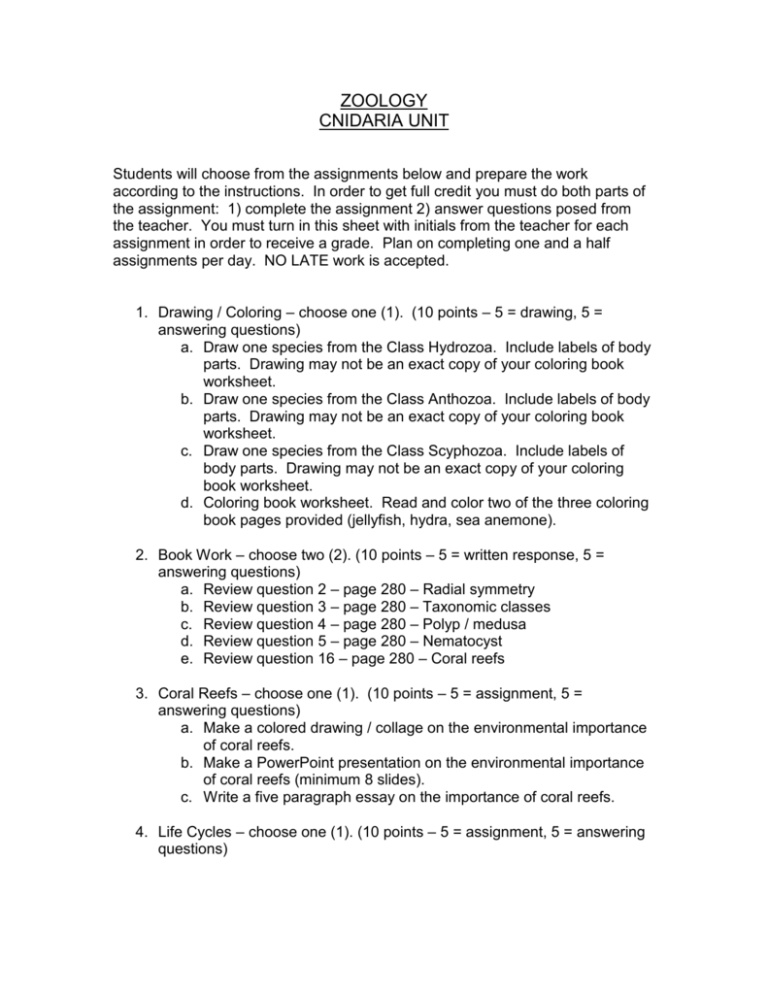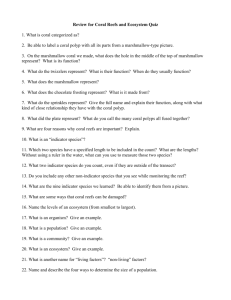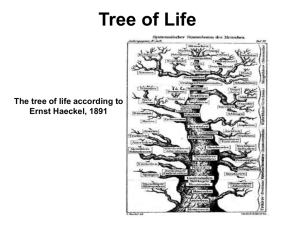Stations_assignments - TeachersWebResource.com
advertisement

ZOOLOGY CNIDARIA UNIT Students will choose from the assignments below and prepare the work according to the instructions. In order to get full credit you must do both parts of the assignment: 1) complete the assignment 2) answer questions posed from the teacher. You must turn in this sheet with initials from the teacher for each assignment in order to receive a grade. Plan on completing one and a half assignments per day. NO LATE work is accepted. 1. Drawing / Coloring – choose one (1). (10 points – 5 = drawing, 5 = answering questions) a. Draw one species from the Class Hydrozoa. Include labels of body parts. Drawing may not be an exact copy of your coloring book worksheet. b. Draw one species from the Class Anthozoa. Include labels of body parts. Drawing may not be an exact copy of your coloring book worksheet. c. Draw one species from the Class Scyphozoa. Include labels of body parts. Drawing may not be an exact copy of your coloring book worksheet. d. Coloring book worksheet. Read and color two of the three coloring book pages provided (jellyfish, hydra, sea anemone). 2. Book Work – choose two (2). (10 points – 5 = written response, 5 = answering questions) a. Review question 2 – page 280 – Radial symmetry b. Review question 3 – page 280 – Taxonomic classes c. Review question 4 – page 280 – Polyp / medusa d. Review question 5 – page 280 – Nematocyst e. Review question 16 – page 280 – Coral reefs 3. Coral Reefs – choose one (1). (10 points – 5 = assignment, 5 = answering questions) a. Make a colored drawing / collage on the environmental importance of coral reefs. b. Make a PowerPoint presentation on the environmental importance of coral reefs (minimum 8 slides). c. Write a five paragraph essay on the importance of coral reefs. 4. Life Cycles – choose one (1). (10 points – 5 = assignment, 5 = answering questions) a. Diagram (draw) or make a PowerPoint Presentation of the life cycle of Aurelia. Include the name of each stage, identify whether it is sexual or asexual, sessile or free swimming, polyp or medusa. b. Diagram (draw) or make a PowerPoint Presentation of the life cycle of Craspedacusta (hydrozoan). Include the name of each stage, identify whether it is sexual or asexual, sessile or free swimming, polyp or medusa. c. Diagram (draw) or make a PowerPoint Presentation of the life cycle of Obelia (hydrozoa). Include the name of each stage, identify whether it is sexual or asexual, sessile or free swimming, polyp or medusa.





